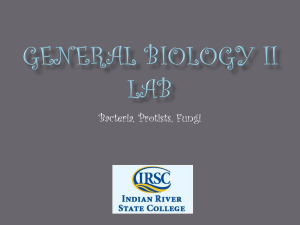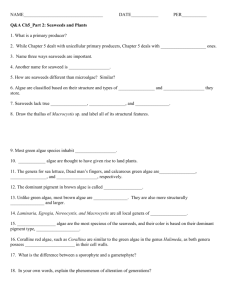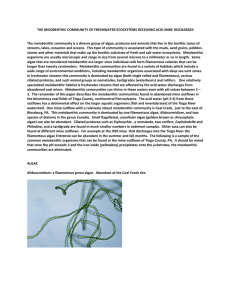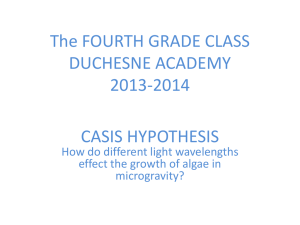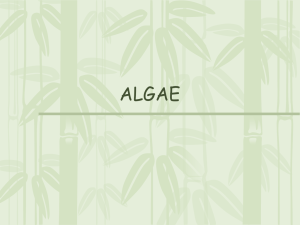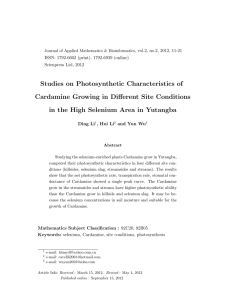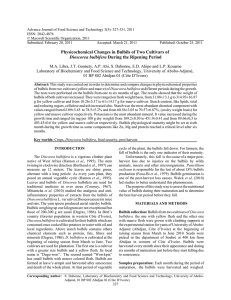Botany - part 1
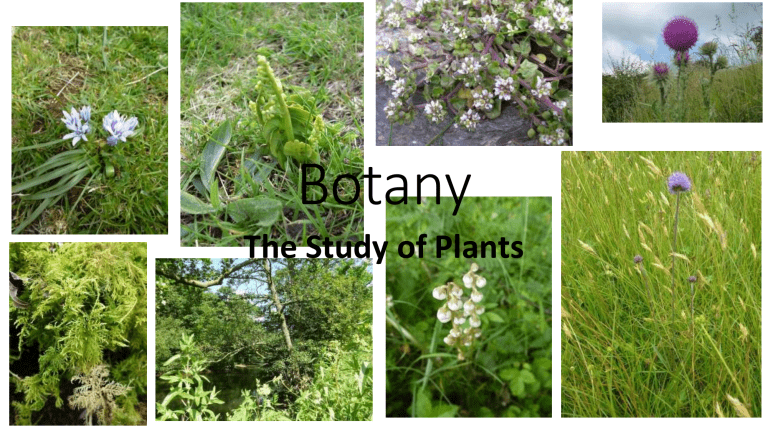
Botany
The Study of Plants
Botany has lots of different areas of study
Taxonomy and classification
Ecology
Physiology
Anatomy
Plant breeding and genetics
Plant pathology
Biochemistry
Pharmacology
Paeleobotany
Plants are unique in that they can manufacture their own food in the presence of sunlight.
Most plants contain a pigment called chlorophyll, which gives the plant its green colour.
Chlorophyll absorbs sunlight and makes the energy available from the sunlight for chemical reactions .
This process is called photosynthesis .
6CO
2
+ 6H
2
O = C
6
H
12
O
6
+ 6O
2
What are plants ?
Plants :
Algae
Lichens
Bryophytes – liverworts and mosses
Ferns
Higher Plants : Trees and shrubs, herbaceous plants including grasses, sedges and rushes.
Classification
Living things are classified on the basis of their anatomy, physiology and behaviour.
Plant classification is based mainly on the structure of the reproductive parts, but can include other characteristics such as leaf shape, structure and arrangement.
The smallest natural group of organisms is the species.
Closely related species are grouped together into a genus ( plural genera)
Similar genera are grouped together into families .
Similar families are placed into classes, and classes into divisions.
po ll en stamen j anther
I
L fila men t recepta cle petal
9-.'-i.4+-r'rt-_.) \ stigma l
U'fr:!---J; - r sty l e f car p e l ovary stem
The Plant Kingdom
Division Algae : Red algae, blue green algae, Green algae – sea weeds and filamentous forms; mostly aquatic
Division: Bryophytes – no specialised conducting tissue
CLASS
1.
Liverworts
2.
Mosses
Division: Vascular Plants( well developed conducting tissue- xylem and phloem)
CLASS
1.
Ferns
2.
Conifers (seeds not enclosed in fruits)
3.
Flowering plants ( seeds enclosed in fruits)
SUBCLASS i.
Monocotyledons ( grasses, lilies) ii.
Dicotyledons (Trees, shrubs, herbaceous plants)
Families
Species
Naming of plant species.
Cuckooflower; Ladies smock; Milkmaids;
Gentleman’s shirt
Binomial system of nomenclature used by scientific community:
Cardamine pratensis
Taxonomists have used the characteristics by which plants are classified to produce keys for identification. These keys are published in books referred to as ‘Flora’s’. One currently in use is :
New Flora of the British Isles 3 rd Edition 2010 Clive Stace CUP. Flora’s are regularly updated.
Most keys are dichotomous and allow plants to be placed in the correct family, genus etc:
Genus Cardamine :divided into 10 species
Extract from key to Cardamine species :
1.
Upper stem leaves with purple bulbils in axils
2.
Stem leaves without bulbils
2 All leaves with 1(-3) leaflets
2. At least some lower leaves with more than or = 5 leaflets
Etc.
Using keys requires knowledge of some specialist terminology.
Cardamine bulbifera
2.
C. trifolia
3.
Using their identification skills ecologists go out to record plants species.
Why do we record plants
• to know where they are found
• to help to understand about the ecology of individual species
• to identify rare species
• which in turn enables those species in need of conservation to be identified – Biodiversity
Action Plans
• to monitor change
• in distribution
• e.g. caused by habitat loss
• in relation to climate change
• in response to conservation management methods
• in timing of certain events, such as flowering – phenology
• to inform the planning process
What constitutes a record
•A plant record should consist of the four ‘W’s’-
•What- species name
•When-date
•Where – Grid reference and locality name, including county.
•By whom – name of recorder
Records can include additional information
• they may be give an idea of abundance of individual species
•Recognised scale of abundance called ‘DAFOR’ scale:
D - dominant
A – abundant
F – frequent
O – occasional
R – rare
• frequency of individual species may be determined, usually using transect or quadrat recording
When did recording start.
Long history of plant recording
William Turner, born in 1510, recorded 300 different British species and named many of them.
John Gerarde (1545-1612) was also a pioneer of botanical recording.
John Ray (1672-1705), did a tremendous amount of work for botanic nomenclature and classification. He completed several local flora’s including that of Cambridgeshire, published in 1660.
After this time an increasing number of publications offers a rich body of historical records.



